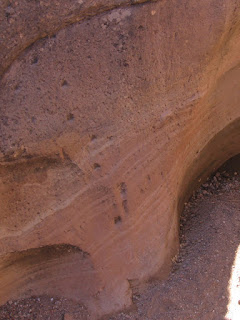It had been almost five months since I was out to Savannah to see Whispering Jesse, where she is slipped at Delegal Creek Marina. I arrived last Friday afternoon at my folks' house there on Skidaway Island, and my dad and I went down to check on the boat right away. She had weathered the time alone better than I expected. The padlocks were not rusted shut, and the cabin was not filled with mildew, but there was a substantial amount of seagull poop on the decks and canvas, and there was some mysterious wetness in the forward berth cushions. After poking around and checking everything out, Dad and I spent a few minutes trying to figure out the new portlight screens that I ordered last fall. They fit nicely, but they're difficult to install and they need to be removed in order to close the portlights -- not very convenient unless we're planning to stay in the same place for an extended period.
The only really alarming issue Dad and I noticed was the large quantity of dirty water in the bilge. I had not plugged the boat into shore power when I left her because I was afraid of a possible electrical short or fire, but apparently the automatic bilge pump ran down the battery and stopped working some time ago. The battery-powered lights still worked, so I wasn't sure right away what the problem was. But on Saturday morning, as soon as I plugged into shore power, the bilge pump kicked in and emptied out the bilge in short order, leaving behind a brown scum. I picked up some concentrated bilge cleaner at the local West Marine store, and it seemed to make a little difference. It may take multiple treatments to get the bilge back to some semblance of clean.
I did the best I could scrubbing off the seagull poop, but like the bilge scum, it will take multiple treatments. After cleaning the decks, I held my breath and turned the key in the engine's ignition. It started right up. I checked the water intake strainer and checked that water was coming out with the exhaust. All seemed good. I let the engine run for about ten minutes while watching the gauges. Everything looked good.
I was pretty confident that the boat would be ready for Dad and me to motor her up to Thunderbolt Marine on Monday morning to get some work done. There were some rigging issues left over from last year's refit that needed to be corrected, and the new diesel engine needed its fifty-hour maintenance. After filling up at the fuel dock, we motored out of Delegal Creek shortly after nine o'clock. About a half-mile out, with the engine running at about two thousand RPMs, I noticed an alarming amount of exhaust smoke blowing out at water level. The temperature gauge was climbing. I reduced the RPMs to idle level and went below to check the water intake. There was hardly any water flowing through the strainer. The through-hull must have been clogged by the growth that had also developed on the hull during its five months in the water. I wondered if I could unclog it with something on board, but the hose makes an S-curve between the strainer and the through-hull, so it would take a drain snake or something similar, which I didn't have. The engine alarm started its piercing cry. There was a significant counter-current and headwind, so I didn't want to turn off the engine or we would find ourselves going backwards. The reduced RPMs allowed the engine to cool enough for the alarm to shut off, and we decided to keep it running until we could make the right turn into Ossabaw Sound at the last Delegal Creek channel marker. At less than one knot of forward headway, it took forever to get out there.
We turned off the engine to let it cool and drifted with the wind and current. Dad was at the helm, and he couldn't get the boat to steer toward the channel markers without any useful headway. The water was too shallow to allow for sailing, or we would have put out a foresail. We would eventually run aground if we continued to drift, so I pulled out my cell phone and called BoatU.S. to arrange a tow. The service works like AAA does for automobiles, and I was awfully glad I had it. The customer service person asked for our boat information and GPS coordinates, and she said a tow boat would be out to meet us within the hour. A few minutes later, Dana from Thunderbolt Marine, the same place where we were headed, called to confirm the tow.
To control our drift, I restarted the engine and kept it at idle speed. We motored along at one knot for over an hour until we saw the red tow boat coming in the distance and received a hailing call on the VHF radio from Capt. Mike. He pulled alongside and tossed a tow rope. I tied it off at the bow, cut the engine and fell in behind for the long tow up to Thunderbolt. We soon passed under the Diamond Causeway bascule bridge at Skidaway Narrows. It is in the process of being replaced by a high, permanent bridge that will better handle the frequent sailboat traffic along this stretch of the Intracoastal Waterway. You can see the construction progress in the photo above, along with our view of Capt. Mike's tow boat.
Instead of arriving at Thunderbolt Marine at noon, as I had predicted, we showed up there at three o'clock. At the entrance to Thunderbolt's harbor, we were able to start the engine, drop the tow line and motor very slowly to the dock, where Mom was waiting patiently for us.
Another adventure, more lessons learned. In addition to the rigging and engine work, I asked Thunderbolt to haul and pressure wash the boat and to clean all the through-hulls. With any luck, our return trip to Delegal Creek Marina next Monday will be less eventful.


 Raising Charlie: The Lessons of a Perfect Dog
Raising Charlie: The Lessons of a Perfect Dog






